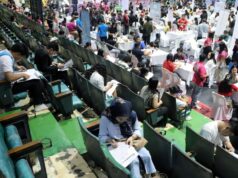Liquidity growth picks up slightly
By Melissa Luz T. Lopez, Senior Reporter
MONEY SUPPLY grew faster in May even as growth in bank lending eased, the Bangko Sentral ng Pilipinas (BSP) announced Friday.
More money circulated in the Philippine economy as supply rose by 14.3% from a year ago, a tad faster than the 14.2% logged in April to log the quickest pace in two months.
Domestic liquidity or M3, which stands as the broadest measure of money in an economy, amounted to P11 trillion as of end-May. Month on month, money supply went up by 1.3%.
Funds from local sources grew by 16.8% last month, picking up from the 16.4% clocked in April amid a sustained rise in bank lending, the central bank said in a statement.
Net claims on the central government also surged by 17.3%, faster than the 13.1% increase the previous month as the government borrowed more money.
Meanwhile, net foreign assets (NFA) expressed in the peso posted faster growth as at 5.4% versus the 4.2% previously.
“Foreign exchange inflows coming mainly from overseas Filipinos’ remittances and business process outsourcing receipts drove the growth in the BSP’s NFA position,” the central bank said.
Foreign assets held by banks also grew due to higher loans and investments in debt papers.
The BSP said overall money supply growth stands “consistent” with inflation and economic activity, as it supports key production sectors.
CREDIT GROWTH EASES
Meanwhile, lending growth slowed in May to 19.4% coming from April’s 19.9%, the central bank said.
Factoring in the reverse repurchase agreements availed by banks, lending eased to 17.7% coming from 19.9% a month ago.
Bulk of the loans went to fund productive sectors to account for 88.5% of the total. These credit lines grew by 19.3% in May — slower than 19.6% previously — led by a 31.3% surge for financial and insurance activities.
Other sectors which took bigger loan lines include wholesale and retail trade, repair of motor vehicles and motorcycles (23.4%); manufacturing (17.7%); real estate activities (15.7%); and electricity, gas, steam and airconditioning supply (11.6%).
In contrast, borrowings for administrative and support services as well as agriculture dropped by 49.2% and 8.3%, respectively.
Retail lending also softened as household credit grew by 18.4%, slower than the 19% climb the previous month. This came on the back of motor vehicle loans and salary-based borrowings, versus a bigger credit card debts.
The BSP raised interest rates by 25 basis points their May policy meeting, but its effect will not be immediately reflected in market rates.
The central bank keeps track of liquidity and bank lending dynamics to ensure price and financial stability, at a time when some economists are flagging the potential overheating of the Philippine economy due to rapid credit growth.



